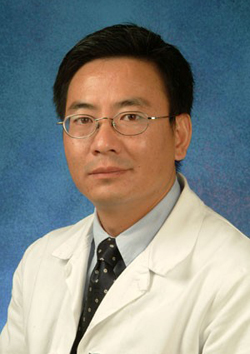Dr. Jianyu Rao
The MIT Technology Review article The Feel of Cancer Cells: Future diagnostic tests for cancer may probe cell stiffness said
Aggressive cancer cells are about 70 percent softer than normal cells, according to research from the University of California at Los Angeles (UCLA). The UCLA researchers are the first to mechanically probe the physical properties of live cancer cells taken directly from a patient. The researchers suggest that such nanomechanical tests of cancer cells might be incorporated into future cancer diagnosis and treatment.
Using atomic-force microscopy, chemist James Gimzewski and pathologist Jianyu Rao measured the stiffness of living cells in samples taken from the fluid surrounding the lungs of patients with cancer. Any cancer cells found in these samples have left the patient’s original tumor, indicating that the cancer is spreading. Gimzewski and Rao found that lung, breast, and pancreatic cancer cells in these samples were much softer than normal cells.
Jianyu Rao, M.D. is
Associate Professor of Pathology and Epidemiology, Director of
Gynecological Pathology, and
Director of the Cytopathology Research and Fellowship Program, UCLA
David
Geffen School of Medicine.
His lab is interested in developing tools for cancer screening, early
detection, and therapeutic monitoring.
The research in his laboratory is focused on developing biomarkers that
can be used for individual risk assessment, early detection, and
therapeutic monitoring of cancer. To reach this goal, he has two
specific research areas.
The first area of research is to study the molecular basis of tumor
morphogenesis, he focuses his effort on investigating how cytoskeletal
proteins, specifically the microfilament actin and the associated
binding proteins, are altered in tumorigenesis. He hypothesizes that
since tumor cells have morphological features that are distinctive from
normal cells, and since actin family proteins play important roles in
regulating cell morphology, adhesion, as well as motility,
investigating these protein changes during tumorigenesis will not only
provide molecular insight for tumor morphology, but at the same time
develop surrogate markers that are more sensitive and specific than
morphological analysis alone. Since the actin network is regulated by
multiple complex oncogenic signal transduction events, including Ras
superfamily small G proteins Rac/Rho/Cdc42, and Src family proteins,
and many of these proteins have been developed as the potential
therapeutic targets, it is possible that an actin centric strategy for
cancer detection/monitoring/prevention/therapy can be developed in he
future.
His second area of research is to develop approaches that can be used
to detect early malignant lesions, especially cancer of the breast,
bladder, and prostate. The detection of low stage malignant and
premalignant lesions is essential for the successful halt, or even the
reversion of malignant progression through chemoprevention strategy.
The focus is to develop simple, high throughput techniques that
can be used to detect expressional abnormalities of multiple genes on a
small sample volume basis. One specific example is to develop
Quantitative Fluorescence Image Analysis (QFIA) as a single-cell
proteomic method for biomarker analysis on cytological
materials.
Jianyu coauthored
Tissue microarray analysis of cytoskeletal actin-associated
biomarkers
gelsolin and E-cadherin in urothelial carcinoma,
Gene expression in epithelial ovarian carcinoma,
Analysis of the Na,K-ATPase α- and β-subunit expression
profiles of
bladder cancer using tissue microarrays,
Immunohistochemical analysis of cyclooxygenase-2 expression in
premalignant and malignant esophageal glandular and squamous lesions in
Cixian, China, and
Comparative Polymerase Chain Reaction Analysis of c-myc
Amplificationon
Archival Breast Fine-Needle Aspiration Materials.
Read the
full list of his publications!
Jianyu earned his MD at Shanghai Medical University in 1984, and did
his residency in
Pathology & Laboratory Medicine at the UCLA School of Medicine from
1994 to 1998. He completed a Fellowship in Urology at
the University of Oklahoma College of Medicine from 1987 to 1992 and a
Fellowship in Cytopathology at the UCLA School of Medicine from 1998 to
1999.
